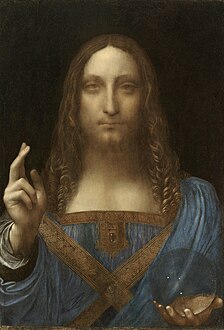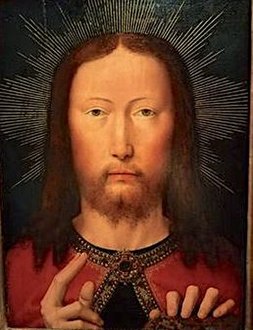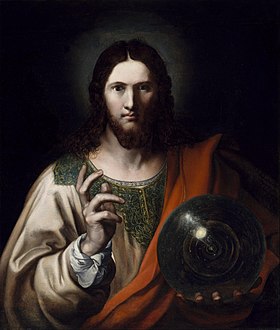
Salvator Mundi, Latin for Saviour of the World, is a subject in iconography depicting Christ with his right hand raised in blessing and his left hand holding an orb (frequently surmounted by a cross), known as a globus cruciger. The latter symbolizes the Earth, and the whole composition has strong eschatological undertones.
Background
The theme was made popular by Northern painters such as Jan van Eyck, Hans Memling, and Albrecht Dürer. There are also several versions of the theme attributed to Titian, notably the one in the Hermitage Museum.
One painting of the subject, simply titled Salvator Mundi, was attributed or reattributed to Leonardo da Vinci in 2011. This painting disappeared from 1763 until 1900 when it was acquired from Sir Charles Robinson. It was at the time thought to be a work by Leonardo's follower, Bernardino Luini, and was purchased for the Doughty House in Richmond, London by Sir Francis Cook. By this time Christ's face and hair had been extensively repainted. A photograph taken in 1912 records the work's altered appearance. In 2017, this painting sold at auction for US$450,300,000, the highest price ever paid for a painting.
Arts
Salvator Mundi has been represented as a central motif in artworks since the 15th century such as:
-
 Carlo Crivelli, Cristo benedicente (c. 1472)
Carlo Crivelli, Cristo benedicente (c. 1472)
-
 Hans Memling, Earthly Vanity and Divine Salvation (detail) (c. 1485). Musée des Beaux-Arts de Strasbourg (also bearing attributes of a Christ in Majesty, such as the crown)
Hans Memling, Earthly Vanity and Divine Salvation (detail) (c. 1485). Musée des Beaux-Arts de Strasbourg (also bearing attributes of a Christ in Majesty, such as the crown)
-
 Joos van Cleve, Christ as Salvator Mundi (circa 1516–1518, Louvre
Joos van Cleve, Christ as Salvator Mundi (circa 1516–1518, Louvre
-
 Leonardo da Vinci, Salvator Mundi (c. 1499–1510), currently owned by Mohammad bin Salman
Leonardo da Vinci, Salvator Mundi (c. 1499–1510), currently owned by Mohammad bin Salman
-
 Gerard David, Salvator Mundi, c. 1500, Philadelphia Museum of Art
Gerard David, Salvator Mundi, c. 1500, Philadelphia Museum of Art
-
 Andrea Previtali, Salvator Mundi (1519), National Gallery
Andrea Previtali, Salvator Mundi (1519), National Gallery
-
 Palma Vecchio, Salvator Mundi (c. 1520), Musée des Beaux-Arts de Strasbourg (depicted without the blessing hand)
Palma Vecchio, Salvator Mundi (c. 1520), Musée des Beaux-Arts de Strasbourg (depicted without the blessing hand)
-
 Titian, Salvator Mundi (1570), Hermitage Museum
Titian, Salvator Mundi (1570), Hermitage Museum
-
 Unknown artist, Salvator Mundi (third quarter of 16th century)
Unknown artist, Salvator Mundi (third quarter of 16th century)
-
Stained glass panel in the transept of St. John's Anglican Church, Ashfield, New South Wales
See also
References
- "How this $100M da Vinci masterpiece flew under the radar for centuries". 2017-11-15.
- "Video: The Last da Vinci | Christie's'".
- Helmore, Edward (16 November 2017). "Leonardo da Vinci painting sells for $450m at auction, smashing records". The Guardian.
External links
 Media related to Salvator mundi at Wikimedia Commons
Media related to Salvator mundi at Wikimedia Commons- Details on de Ganay's Salvator Mundi